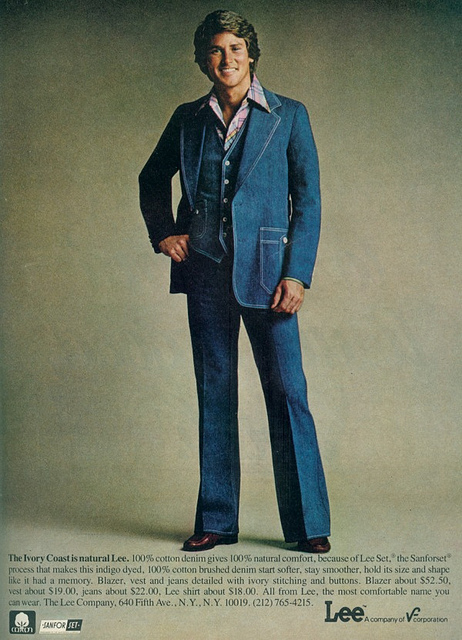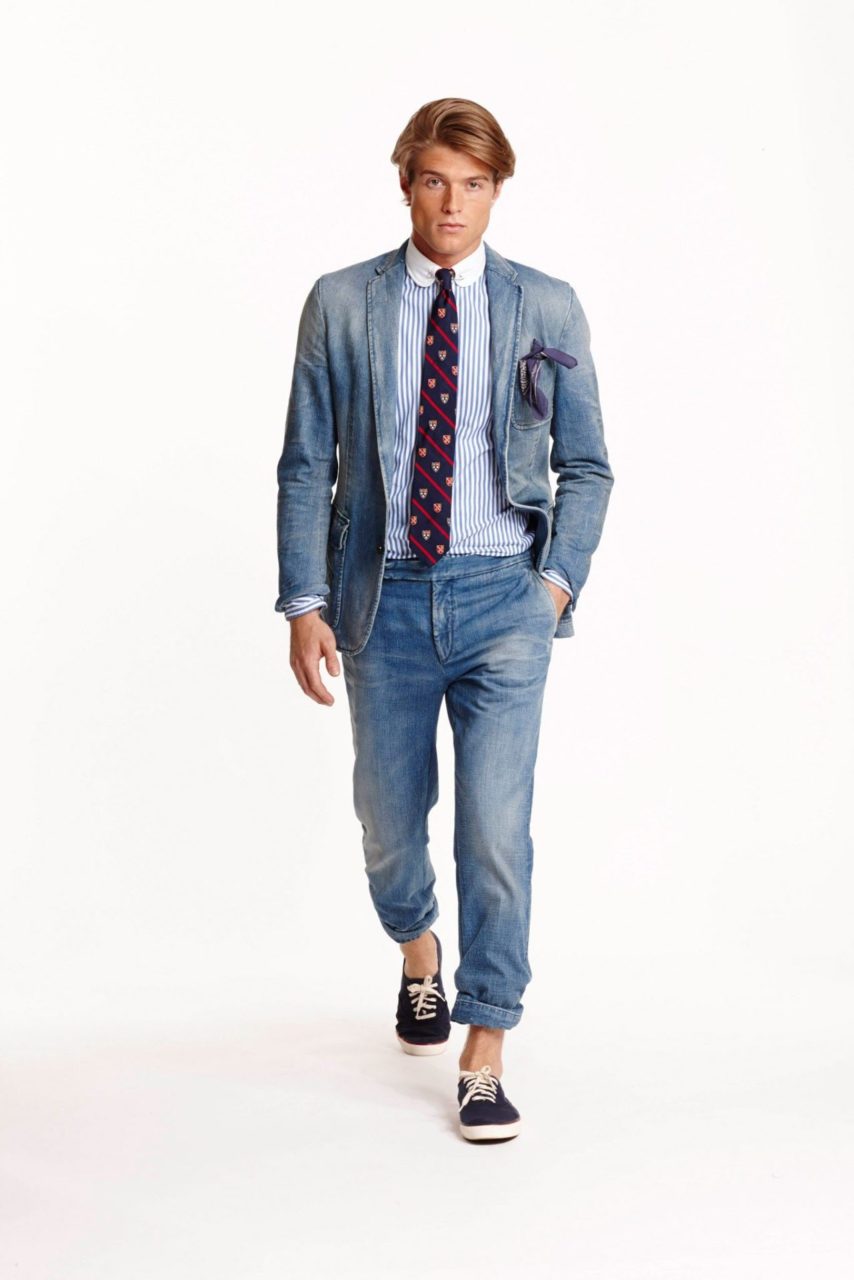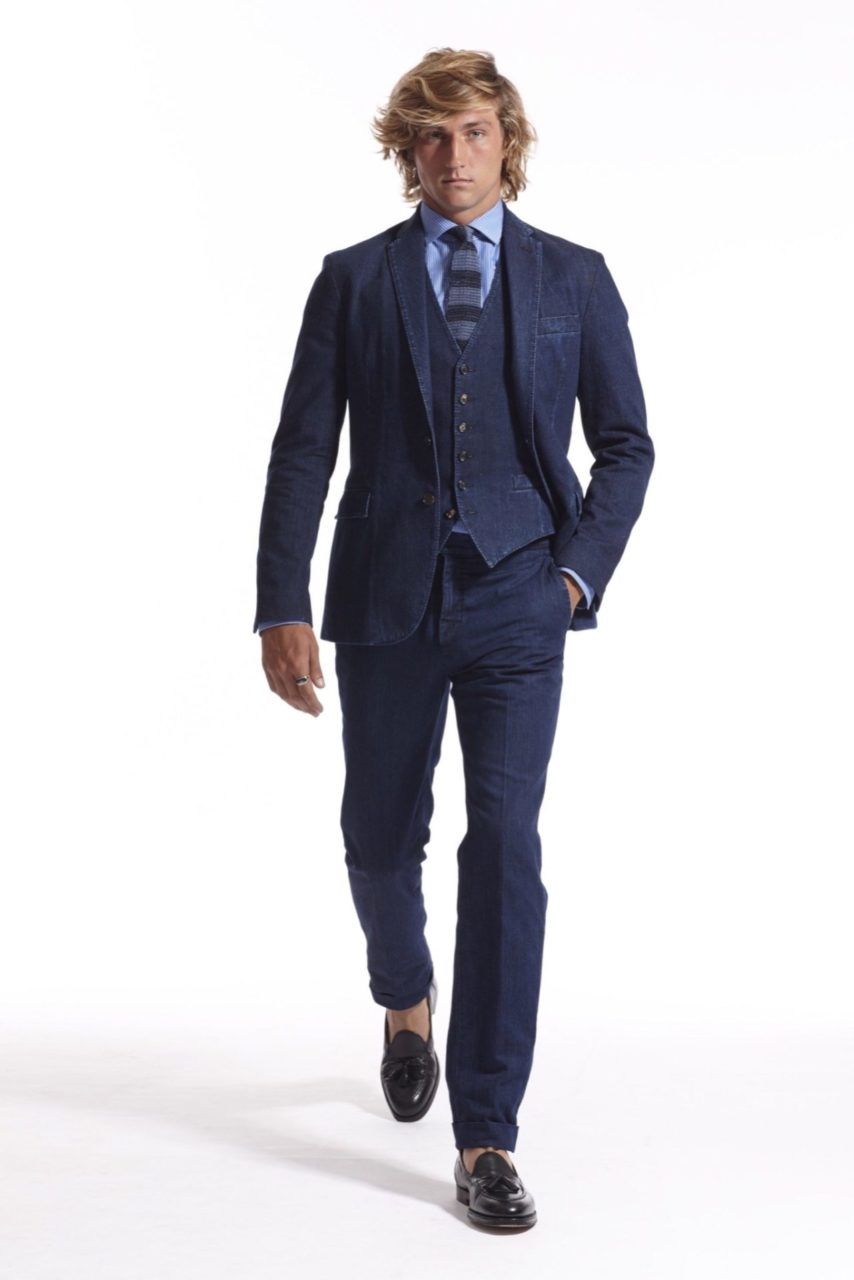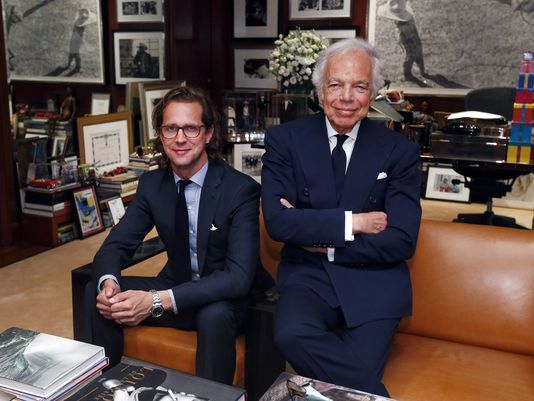Playing on the tradition of the 1970s leisure suit, American designer Ralph Lauren, presented a three-piece denim suit as a part of his 2015 luxury Purple Label Collection. Hybridizing two classically favored menswear items such as the navy suit and contemporary favorite dark denim, Lauren is able to suggest the marriage of two very distinct garments. The look tiptoes the line between dressy and casual daring the fashion industry and consumers alike to keep evolving beyond the status quo.
About the Look
A subversive entry in his spring summer collection, this denim three-piece suit was part of Ralph Lauren’s Purple Label (RLPL) Collection (Fig. 1). An integral part of the classic Ralph Lauren brand, Purple Label is tailoring driven featuring haberdashery and elegance throughout the collection. This slim, but natural, silhouette is contemporary and clean with broad shoulders, high-notch lapels, and sleek flap-waist pockets (Fig. 2). In a wrap-up article, Jean E. Palmieri, writer for WWD, commented: “The strongest statements in tailoring came in shades of blue…and a lightweight denim three piece suit that looked more like a rich navy linen.”
This collection played emphatically on the depth of blues and browns in a way that highlights the the sophistication of texture and edginess of fabrics that is possible with classic menswear staples commonly found in varieties of navy blue (Flusser 19).
Lauren, known for his traditional and aspirational imagery, has become the master of packaging inspiration within a romantic narrative. In this sense, this approach to design has helped Ralph Lauren become a true lifestyle brand (Hancock 41).
Fig. 2 – Diagram of a single-breasted notch lapel suit. Source: Liem Ngo
In the case of Purple Label, the vision is luxury and the sensibility is modern. Silhouettes are sophisticated and chic with both double and single-breasted suits. Suits in bold checks and stripes are anchored by high collared shirts, plump ties, and collar pins emanating a strong and sophisticated aura (Fig. 3). It is clear these garments are made for a man that takes great pleasure in dressing well. Lauren himself remarked of the collection, “this is wearable…and it’s clothing with a hint of international flavor for the young guy who loves fashion” (Palmieri).
Fig. 1 – Ralph Lauren Purple Label (American, 1939-). 3-Piece suit, Spring/Summer 2015. Denim, cotton, silk. Source: Vogue
A denim suit inevitably evokes Bing Crosby’s famous 1951 denim suit (Fig. 4) made for him by Levi’s when the singer had earlier been nearly ejected from a posh Vancouver hotel for wearing all denim; wearing an all denim suit became known as a “Canadian Suit” in the aftermath of the uproar. Lauren’s three-piece suit instead seeks to capture the zeitgeist in the way that 1970s denim leisure suits (Figs. 5-6) were able to (McClendon 200). That is to say, playing upon the balance between work clothes and play clothes. An inky blue denim in a slim straight fit has been a workhorse to a well rounded wardrobe since the mid 2000s as a staple bottom piece (van den Broeke). Lauren merges this vision to another staple item, e.g. the navy suit and in doing so presents a contemporary idea in a highly relevant manner.
On view at his Madison Avenue offices, the SS 2015 collection was presented to the likes of WWD, Vogue, and other high-profile editorials. The most common picture for the collection can be seen in Fig. 3. Here, flanked by two other daring three piece looks, the denim three-piece is ironically offered as the much more subdued option. Appearing more like a mottled four-season wool or linen, it no doubt would raise the eyebrow of the most conservative skeptics. Following the presentation, Lauren is quoted as having remarked, “We go where we need to go. People don’t tell you what they want, they have to be shown” (Palmieri).
As the first denim suit ever shown by RLPL, it was precedent setting for the brand and a clear effort on the part of Lauren to expose his audience to a tastefully diverse spectrum of clothes.
As expected, reactions have been mixed. From the ultra conservative, there is the often trite reference to the ‘Canadian Suit,’ and countless references to the Justin Timberlake and Britney Spears’ matching denim outfits on the red carpet at the 2001 American Music Awards. According to Kyle Stock, writer for Bloomberg, it is not the clear winner for those holding CEO status and in need of a ‘power suit.’ Others, going so far as to reference Bing Crosby’s debacle with a Canadian hotel, were only able to advise those looking to don the look a healthy dose of morning boldness as this isn’t a look for the faint of heart. [One can only imagine their reaction to the limited edition reissue of the Bing Crosby’s suit in Spring/Summer 2014 (Fig. 7).]
About the context
While the suit was a statement in and of itself, it was the signature styling that truly makes this a Ralph Lauren look. In his Bloomberg article “A Denim Suit for Business Dudes? Ralph Lauren Thinks So,” Stock makes this striking observation: “Somehow this isn’t a stretch for Ralph Lauren, a brand that has long woven together the dusty duds of the American West with East Coast collars and cuffs.” In this particular look, the suit is styled with a watch fob and collar pin. Undoubtedly American, it is this uncanny ability to meld different time periods of North American life that Lauren is able to conjure from his audience time and time again. Indeed, sporting a side part and classic blue buttoned shirt, Lauren’s look captures a bit of Ivy style from afar, but the denim fabric choice adds a fourth dimension making it relevant, clean, and modern. As guest writer for Heddles, Amy Leverton remarks in her article “The White Oak Economy – How Millennials are Changing Retail,” that it is particular of note how customers of this generation are much more savvy about their purchases:
“despite the current high levels of unemployment, you are a very powerful spending group. You are one of the largest generations in living history …[and] you are also savvy buyers and buy into a brand’s story more than previous generations. You care about what you buy and through the explosion of online blogs and e-commerce sites, you have started to get pretty picky about who you buy into.”
Here, Leverton suggests that the trends in how menswear shoppers buy today is affected by much more than aesthetics and price tag. It is evident that both the narrative of the brand and the quality of construction have become defining characteristics. Lauren’s ability to channel this distinct American flair into a timeless look is part of his range of intangibles that allows him to build a connection with his shoppers. By playing with contemporary ideas in suiting and denim culture, a new forum for menswear dialogue is able to flourish within this world he’s created. Here, Leverton suggests that the trends in how menswear shoppers buy today is affected by much more than aesthetics and price tag. It is evident that both the narrative of the brand and the quality of construction have become defining characteristics. Lauren’s ability to channel this distinct American flair into a timeless look is part of his range of intangibles that allows him to build a connection with his shoppers. By playing with contemporary ideas in suiting and denim culture, a new forum for menswear dialogue is able to flourish within this world he’s created.
Fig. 5 – Three-piece denim leisure suit, 1970. Source: Voices of East Anglia
Fig. 6 – Typical denim leisure suit styled for the ’70s with bold underpinnings, 1970. Source: Voices of East Anglia
Fig. 7 – Bing Crosby’s denim reproduction suit by LVC. Limited to 200 pieces worldwide. Spring/Summer 2014. Source: Pinterest
Fig. 8 – Example of tuxedo with denim, 2015. Source: Pinterest
Fig. 9 – Broken in suit for Polo division. Polo 2015 Presentation. Source: Vogue
The idea of a denim suit is unique in that it plays off the trend of a ubiquitous casual fashion garment–jeans–but the approach and presentation is more or less the opposite. The point being that the shaping of the three-piece suit or even jacket for that matter out of denim is completely counter-intuitive. While denim jackets have been a popular option in the last several years, the departure from their utilitarian nature makes Lauren’s ensemble a special case. In that sense, it is an anomaly for a structured jacket such as this to fall within the same category as say, a chore jacket or denim safari coat.
Yet as Renzo Russo notes in a New York Times piece on the overall state of denim in fashion:
“A tuxedo jacket over destroyed denim is totally modern.” (Trebay)
This observation embodies both the state of menswear and current trend in denim (Fig. 8). An increased fondness for the ability to dress up or dress down an outfit, denim continues to be a driving force. Also, with the explosion of the internet, more and more men are showing interest in construction details, build quality, and country of origin. As noted by Minya Quirk in Vogel’s Contemporary Menswear, with online communities dedicated to the discourse of fashion the influence of street and urban culture is rapidly changing the face of both denim and the idea of suits (72). Instant access to information and pictures has had dramatic effects on trend cycle, sending designers on a chase to find the latest and greatest. The only constant is knowing that experimentation is going to influence what is to come.
The relationship of this suit to the rest of the collection is more apparent in the silhouette and color palette. As referenced above, the trim arms and legs with nipped waist in classic color combinations is well suited to the identity of the Purple Label line and highly characteristic of the sophistication that it is expected to bear. Harkening back to the relationship between quirky and timelessness, GQ writer Matt Sebra comments of the SS 2015 offerings that: “[this season’s] wardrobe would be anything but boring,” as well as, the clever use of pattern and tonality was a “fresh spin on luxury menswear” and finally that the RLPL presentation was a great effort at making the three piece suit feel “unstuffy.”
As a brand in its entirety, it is also worth mentioning that a washed denim suit was presented alongside in the Polo collection (Fig. 9). Like a younger brother, the Polo division takes cues from RLPL but imparts an edgy twist. In this look, it is washed heavily for a worn-in look more characteristic of the old West. It is also unexpectedly accessorized with a contrast club collar shirt and heraldic tie evoking an East Coast education. This juxtaposition of origin is another favorite of Lauren and continues to develop a new hybrid of American sportswear and urban wear. In any case, the cohesiveness between each individual brand to bridge some gap of Americana is what helps to convey the ‘Ralph Lauren man’ (Sebra).
Its Afterlife
The three-piece suit is a standout within the “2010s to Present” section of the Museum at FIT’s 2015-16 exhibition, “Denim: Fashion’s Frontier” (Fig. 10).
Curator Emma McClendon had this to say of this Purple Label look:
“Ralph Lauren … fuses a modern, slim silhouette with the classic three-piece suit. Rendered in denim, it evokes the tradition of the 1970s denim leisure suit, but for the runway it was accessorized with a watch fob chain, lending it a late 19th-century feel. In essence, this single look brings together several disparate references as a historical bricolage.”
As referenced earlier, the three-piece denim suit was presented alongside a washed version from its younger brother label Polo (Fig. 9).
Possibly a testament to its success in either industry influence or sales, a washed denim version was again featured in the Polo spring summer 2016 campaign (Fig. 11). Vogue writer Nicole Phelps was won over, disclaiming in her article:
“Two of the best looks highlighted Polo’s range. A three-piece denim suit faced off against mismatched sweats topped by a herringbone tweed blazer. Both outfits looked new, but the funny thing was you could picture Ralph himself in either of them.”
This time around in a dark wash, the three-piece suit is styled with a striped knit tie and leather slip-ons, again further straddling the line between dressed up and dressed down. Ultimately, it is these conscious choices year after year as a design house to repeatedly question the viability of the denim suit that defines the brand.
Fig. 10 – Museum at FIT installation, “Denim: Fashion’s Frontier,” Spring 2016. Gift of RL Corporation, 2015. 47.2. Source: The Museum at FIT
Fig. 11 – Dark denim suit for Polo division. Polo 2016 SS Presentation. Source: Vogue
About the Designer
one of America’s foremost designers, Ralph Lauren (Figs. 12-13), born Ralph Lifshitz is a Bronx, New York native; he was born in October 14, 1939. In school, Ralph pursued business science as well as serving a brief stint in the army. Being heavily influenced by movies and military surplus at the time however, had given him the catalyst to strike it out on his own (Hancock 43). Starting his own tie brand of wider, colorful ties, he named it Polo and from there his vision began to take shape. He later expanded to menswear (1969) before ultimately introducing womenswear in 1971 (Vogue Biography).
Now in its 49th year, the brand continues to be enormously successful with an empire stretching from everything from made-to-measure tailoring to ready-to-wear basics, sleepwear, and even home. As referenced earlier, the three-piece denim suit was presented alongside a washed version from its younger brother label Polo. Possibly a testament to its success in either industry influence or sales, a washed denim version was again featured in the Polo spring summer 2016 campaign.
Fig. 12 – Ralph Lauren with wife Ricky, fashion designer. November 1, 1977. Source: Susan Wood/Getty Images
Fig. 13 – Designer Ralph Lauren, right, poses in his office with Stefan Larsson, global brand president, 2015. Source: Jason DeCrow
Pinned as his greatest achievement was his unrivaled ability to bring his customers into a world where the love of Americana is collaged into endless stories marrying together the different regions and time periods that surrounded his childhood. As described by writer Jean E. Palmieri:
“Lauren’s greatest achievement was creating an all-encompassing aspirational lifestyle disguised as a clothing brand. His labels…are best experienced in their immersive retail environments and through photographer Bruce Weber’s cinematic ads.”
She goes further to state regarding its relationship with the all encompassing importance of social media:
“But the [new] aspirational lifestyle is [found] in the most unlikely places, often via the frenetic streams of Instagram (where Ralph Lauren has 940K followers and counting), Tumblr, and e-commerce, platforms that are free from the confines of physical space. Everything is a brand.”
Simply put, the Ralph Lauren brand and great denim is as desirable as ever.
References:
- Boyer, G. Bruce. True Style: The History & Principles of Classic Menswear. New York: Basic Books, 2015.
- Fashion Institute of Technology. Fashion Designers A-Z: The Collection of the Museum at FIT. Cologne: Taschen, 2012.
- Flusser, Alan. Dressing the Man: Mastering the Art of Permanent Fashion. New York: Harper Collins Publishers, 2002.
- Hancock, Joseph. Brand/story: cases and explorations in fashion branding. New York: Fairchild Books, 2016.
- Leverton, Amy. “The White Oak Economy – How Millennials are Changing Retail. ” Accessed April 28, 2016. Heddles
- Marsh, Graham. Denim: From Cowboys to Catwalk: A Visual History of the World’s Most Legendary Fabric. London: American Classics, 2005.
- McClendon, Emma and Fred Dennis. Denim: Fashion’s Frontier. New Haven: Yale University Press, 2016.
- McClendon, Emma. “Denim: Fashion’s Frontier: 2010s to Present.” The Museum at FIT. Accessed April 28, 2016. http://exhibitions.fitnyc.edu/denim-fashions-frontier/?url=installation_09-150×150.jpg
- McNeil, Peter. The Men’s Fashion Reader. New York: Berg, 2009.
- Palmieri, Jean E. “Ralph Lauren Men’s RTW Spring 2015.” Accessed April 21, 2016. WWD
- Phelps, Nicole. “Ralph Lauren Men’s RTW Spring 2016.” Accessed April 19, 2016. WWD
- Sebra, Matt. “First Look: The World Of Ralph Lauren Spring-Summer 2015.” Accessed April 22, 2016. GQ
- Stock, Kyle. “A Denim Suit for Business Dudes? Ralph Lauren Thinks So.” Accessed April 28, 2016. Bloomberg
- Tagariello, Maria Luisa. Masters of Fashion: The Leading Figures Behind the Dream. Italy: White Star Publishers, 2014.
- Trebay, Guy. “At Ralph Lauren, Purple Label, DSquared2 and Giorgio Armani, a World View.” Accessed April 19, 2016. NY Times
- van den Broeke, Teo. “20 Things Every Man Should Have In His Wardrobe.” Accessed April 22, 2016. Esquire
- Vogel, Steven. Contemporary Menswear: A Global Guide to Independent Men’s Fashion. London: Thames and Hudson, 2014.
- Vogue Biography. Who’s Who: Ralph Lauren. Accessed April 21, 2016. Vogue





















